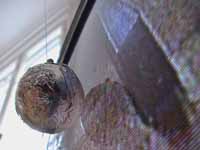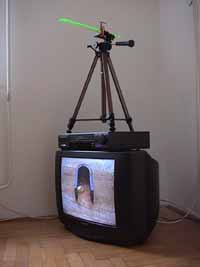








|
Attraction, 2001
Interactive video installation
The structural construction as well as the pictorial contents of Attraction, like earlier media works of KissPál, can be characterized by technical simplicity. The effects lie in the author's attitude; he uses the by-product of electronic picture illustration technologies as a starting point. Making the static electricity appearing on the screen something esthetic is in itself a gesture, and making it thematic is of special importance for two reasons. First of all, it lifts the technological presence behind the screen to the level of a structural part of the work. Secondly, it gives an opportunity for the idea of interactive technology to gain different hues. In this way it touches upon the essential three-part reference system of media-artworks: it contains the moderate critique of media (the by-product as esthetics), sketches the uniqueness of "screen-based" technology (the screen as interface ), while expanding the interactive duality of the recipient-media object with the actions of a third party.
*.
 |

|
The by-product in the work-- also the operator of the installation-- is static electricity. It reveals the duality of an existing concrete screen and a metaphoric surface, meaning that media objects based on the screen are not a "window" in the traditional sense, but an interface that works as a connecting surface between the two separate worlds of pictures and communication. The complex structural characteristics found in the background of the works of media-artworks are the undeniable effecting and accompanying factors of its physical presence. The palpable (the body of the machine, the cables, switches: in sum, the hardware) and the operating (electricity, data, code: the software) factors are basic building blocks, which can not be overlooked in the installation's actual construction. By lifting any of these components to a main role can be looked upon as an informal gesture, which simultaneously expresses a critique of "hi-fi" portrayal and an allusion to the unique structural features of the media.
*
In our world split into the two parts of observer and portrayer, the amusing connection of picture content and function can be seen as an experiment directed towards the re-establishment of unity; its "effect"(the picture of a magnet working as a magnet) is one of the main pillars of the work. In this relation, the portraying, metaphoric, and functional contents of the picture reflecting on each other model an ideal state in which hermeneutic doubt disappears and the noise of communication quiets. Though it presents the highest human aspiration-- the created world acting naturally-- it achieves completeness by expressing its knowledge of self-identity. It is different than a picture taken out then reinserted unmodified with a conceptual gesture, in the sense that while the contents of the former are borne by the knowledge of the gesture done, the latter is made sensual by behavior in a broader sense. Therefore we are witnesses to an experiment in reunification of a universe split apart by the appearance of technical representation. This is presented not by mimesis but a gesture breaking through the interface, connecting two sides of the world cast onto either sides of a screen.
*
The interactive quality of the installation comes about by the observer's movement in space; it is connected to the work by a hand-crafted "sensor". At first glance the device is no different than a usual infrared sensor. On the level of operation, this device, similar to an automatic sensor, reacts mechanically to the observer's movements: when the observer step in front of the infra-ray coming from the remote control, it turns the "machine" off and on. Since this is a remote control clamped into a vice that is operating the function and not some sort of hidden sensor, its presence gains a new dimension. The function of the remote control fastened to a camera tripod, is different than an automatic sensor's dead state because of its material presence and in the way it works; the C-clamp replacing the human finger simply, yet effectively portrays the robot-creating desire of the human spirit and the role filled by remote controls in our lives. The dreams of a sustained moment, the perpetuum mobile, and the perfect machine are all present in this simple device, which (self-ironically) makes the observer a part of the interactive sphere by simultaneously operating a model of its own defenselessness.
Maria Marcos
| |

